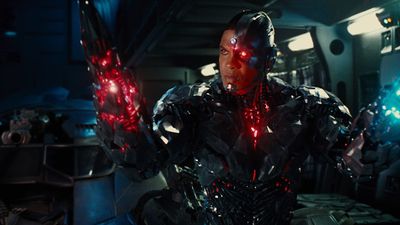How Cyborg Saved 'Zack Snyder's Justice League'
In Zack Snyder’s Justice League, Cyborg’s arc is the most fully realized in the story, and without it, the film would feel nearly as hollow as the original.
In Zack Snyder’sJustice League, Cyborg, like countless Black folks before him, is called upon to save the world before he can process his own trauma. In some ways, that struggle is something that Ray Fisher, the actor behind the portrayal, might have related to in the latter stages of filming for the original Justice League.
Last July, Fisher accused the film’s replacement director, Joss Whedon, of being “gross, abusive” and “unprofessional” to cast and crew members for the project. Earlier this month, Fisher followed up with claims that Warner execs had worked to remove Black characters from the original JL film. Now, the character arc of Fisher’s Cyborg — one that was a footnote in the original — is the emotional and thematic connective tissue of Zack Snyder’s Justice League, the newly released film Snyder had intended to complete before stepping away from production after his daughter committed suicide four years ago.
The movie is one that rabid DC fans demanded to be released shortly after Whedon’s underwhelming version hit theaters in November 2017. The possibility of it seeing the light of day solidified after Snyder confirmed its existence back in 2019. After a two-year grassroots campaign, the film — colloquially known as the "Snyder Cut" — was released on HBO Max on Thursday (March 18th). By the end of the third tacked-on bonus scene, it’s clear that Snyder pulled off a heroic feat. The expanded cut, which has a monstrous four-hour running time, turns blip-on-the-radar character development into catharsis, forced interactions into genuine camaraderie, and a cheap Avengers impression into a superhero epic.
The change is embodied by Fisher’s Cyborg. With his utter humanity and the ability to hack into mystical, extraterrestrial technology, Cyborg holds the key to saving the world. Fisher’s pensive stares and a familial arc, which comes full circle, help save the film from forced Marvel Cinematic Universe-esque jokes and disconnectedness of the original.
In the Snyder cut, we get a more wholesome look at the Cyborg mythos, as well as the endless utility of his gifts. We see the accident — the loss of a loved one and the subsequent emergency procedure — that led to his powers and changed his life forever. We get glimpses of a strained father-son relationship and the bitterness and eventual reconciliation that can accompany it. We also see the spurts of heroism he’d performed before he ever joined the League. In one scene, we learn about his pre-accident days that saw him once hack into his high school virtual grade book so he can improve the grade of a classmate who’s fallen onto hard times. Once his body is infused with technology from a Mother Box — an alien entity with endless energy and the capacity to give life — he levels up his hacking skills to save a struggling single mother from poverty. By the end of the movie, Cyborg, initially ashamed of his cybernetic enhancements, embraces his otherness and uses his new set of abilities as he finds the resolve to become a true hero.
After the release of the Snyder Cut on Thursday, Fisher spoke on the way he connected with the character and the arc displayed in the new movie.
“As a Black man that grew up with an absent father, #Cyborg’s story has always hit differently for me,” Fisher said in a tweet. “Family and reconciliation are some of my biggest takeaways from #ZackSnydersJusticeLeague. It’s not just comic book movie — it’s a study of the human condition.”
There are other improvements in the film, too. We get to see an iconic DC villain, Darkseid, and a surprise appearance from an unexpected hero. The action scenes are more elaborate and more viscerally thrilling. Aquaman’s royal background is explored in more depth, Flash (Ezra Miller) gets to showcase his powers more, the Mother Boxes are given more context, and the characters spend more time together, so their interactions feel less stilted and arbitrary. The relentless guilt that drives Batman (Ben Affleck) to form the Justice League is more fully illuminated through conversations with Alfred (Alfred Pennyworth). The struggles of Cyborg and Aquaman (Jason Momoa) to join forces with the team gives weight to a theme of unity and its difficulty, which previously felt like it was just an excuse for a cheesy superhero movie tagline.
Mired in thin character development and the inherent difficulty of squeezing so many plot points into one film, the original Justice League lacked cohesiveness and the true weight of human identity. With the Snyder cut’s thematic additions, the “new” Justice League is an almost entirely different movie. It’s a much better film, and a self-contained reminder of the stories that can be lost in Hollywood politics and the dangers of exclusion, whether due to prejudice, cinematic corner-cutting, or some combination of both. Sure, other plot points from the film were cut, too, but for Cyborg, the cuts meant he was reduced to a brooding shadow without much reason for why. Cyborg’s arc is the most fully realized in the story, and without it, the film would feel nearly as hollow as the first.
__
Peter is a writer and editor who covers music, movies, and all things dope. Catch him in the Hyperbolic Take Chamber on Twitter @pellz_.
